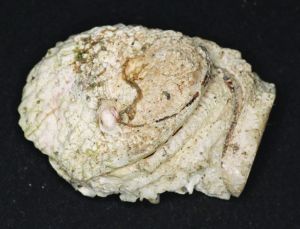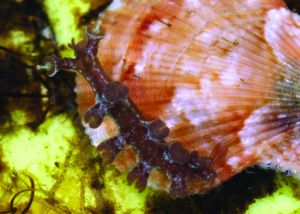|
The Superfamily Chamoidea contains a group of bivalves, commonly known as jewel box clams, which live with one valve cemented to a hard substrate such as coral, rock or other shells. They have been confused with oysters and spiny oysters (Spondylus) and are highly variable in form because the lower valve conforms to the substrate whilst the upper valve erodes, losing colour and sculpture in the process. This is not a speciose group of bivalves and most species (including the larger ones) are tropical and live in shallow water. European Seashells (Poppe & Goto, 1993) includes two jewel box clams, Chama gryphoides and Pseudochama gryphina. Their distributions are given as Gibraltar south to Senegal with Indian Ocean occurrences for Dar es Salaam and Mauritius for the former, and Portugal south to Angola for the latter. Both occur in the Canaries and the Mediterranean. So a record for the latter off Chesil Beach is something of leap in distribution. Steve Trewhella, a Dorset man with a strong involvement in local marine conservation issues and activities, regularly walks stretches of the Dorset coast in search of unusual flotsam and strandings. On 11th March he was walking the shore looking for fresh seafans washed up in the severe storm the night before, when he found a broken plastic fish box at Chesil Cove (SY682733). There were hydroids on the box, but he noticed only one shell, with animal, which was attached in the grooves of the box handle. This he carefully removed and subsequently removed the shell with forceps, sending it to me with a tentative identification of Chlamys distorta (hunchback scallop). It was immediately evident that it was something rather different (see photos) and after looking at the literature I have concluded the shell is Pseudochama gryphina. To the best of my knowledge this is the first record of the species for Britain and Ireland and possibly northwest Europe. A couple of months earlier Steve had found an old plastic crate cast up on Chesil Beach. This crate was supporting a more diverse fauna which included Aequipecten opercularis, Heteranomia squamula, and three species of goose barnacle (Lepas pectinata, L. anatifera and the buoy barnacle Dosima fascicularis). The latter is a pelagic species which makes its own float, thus mimicking the lifestyle of Janthina. However it also attaches to hard surfaces. In addition three nudibranch species were observed on bryozoans attached to the crate: Hancockia uncinata, Eubranchus pallidus and Facelina auriculata. These sea slug identifications were confirmed by Bernard Picton. For a number of years now, seasoned beachcombers around the British Isles have been recording an increasing number of true southern species which are beyond their northern limit of geographical distribution as recognised hitherto. Steve’s discoveries show that beached debris is as worthy of investigation as the more traditional strandline. |
Figure 1: Chesil litter
|
Old fish boxes and hidden jewels – a first record of Pseudochama gryphina from northwest Europe.
Issue
20
Page
17


 Figure 2: Pseudochama gryphina
Figure 2: Pseudochama gryphina Figure 3: Hancockia uncinata
Figure 3: Hancockia uncinata Figure 4: Eubranchus pallidus
Figure 4: Eubranchus pallidus Figure 5: Facelina auriculata
Figure 5: Facelina auriculata